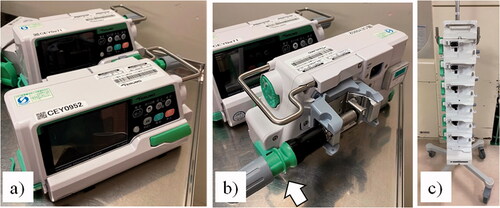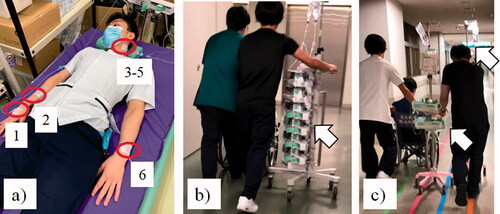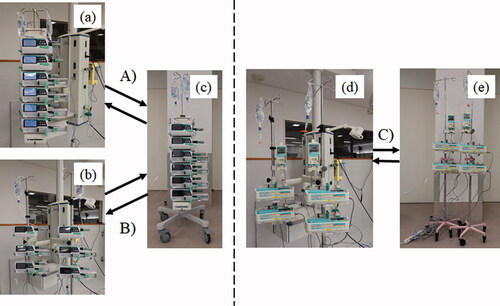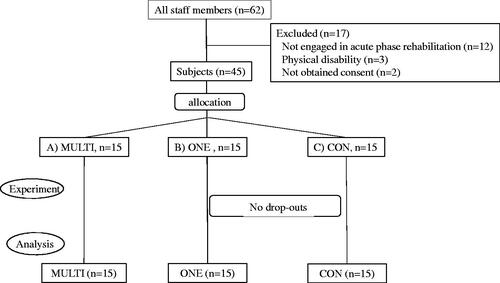Figures & data
Figure 1. A one touch clamp and rack smart pump. (a) smart Internet of Things (IoT) pump; (b) one-touch pole cramp attached with smart pump; (c) multi-layer rack. The one-touch pole clamp allows the pump to be easily attached to or removed from the pole using the clamp indicated by the white arrow in Figure 1(b). In addition, the pump can be mounted in the multi-layer rack with the one-touch clamp attached.

Figure 2. Study Design. (a) Simulated patient attached through six infusion lines with two infusion pumps and four syringe?pumps; (b) Round-transport of MULTI and ONE; (c) Round-transport of CON Multi-layer rack group (MULTI), One-touch pole clamp group (ONE), control group (CON) Red circle in Figure 2(a) shows the six lines attached to the simulated patient with tape, two lines to the right forearm (1,2), three lines to the left part of the neck with a central venous catheter (3–5), and one line to the left forearm (6). White arrow in Figure 2(b) shows two smart infusion pumps and four smart syringe pumps mounted in the multi-layer rack in MULTI and ONE groups. White arrows in Figure 2(c) show old traditional type two infusion pumps and four syringe pumps attached with two drip-poles in CON group (One pole is behind the subject).

Figure 3. The experimental groups. (A) Experimental group (1) (MULTI); (B) Experimental group (2) (ONE); (C) Control group (CON) (A) In MULTI group, the subject detached the four smart syringe pumps and two smart infusion pumps from the one multi-layer rack (a) and attached to the one mobile multi-layer rack for transportation (c). (B) In ONE group, the subject detached the four smart syringe pumps and two smart infusion pumps, that were attached one-touch pole clamp from the two-drip pole stands (b) and attached to the one mobile multi-layer rack for transportation (c). (C) In CON group, the subject detached the four traditional type syringe pumps and two traditional type infusion pumps from the two drip-pole stands (d) and attached to the two-mobile drip-pole stands for transportation (e). (A–C) After returning to the laboratory, the subject detached the pumps from the mobile drip-pole stand or mobile multi-layer rack to the original drip pole stand or multi-layer rack.

Figure 4. Flow Diagram. Multi-layer rack group (MULTI), One-touch pole clamp group (ONE), control group (CON).

Table 1. Demographic characteristics of the subjects.
Table 2. Time needed for pump replacement and the round-transport.
Table 3. Perceived burden of the pump replacement.
Table 4. Perceived burden of the round-transport.
